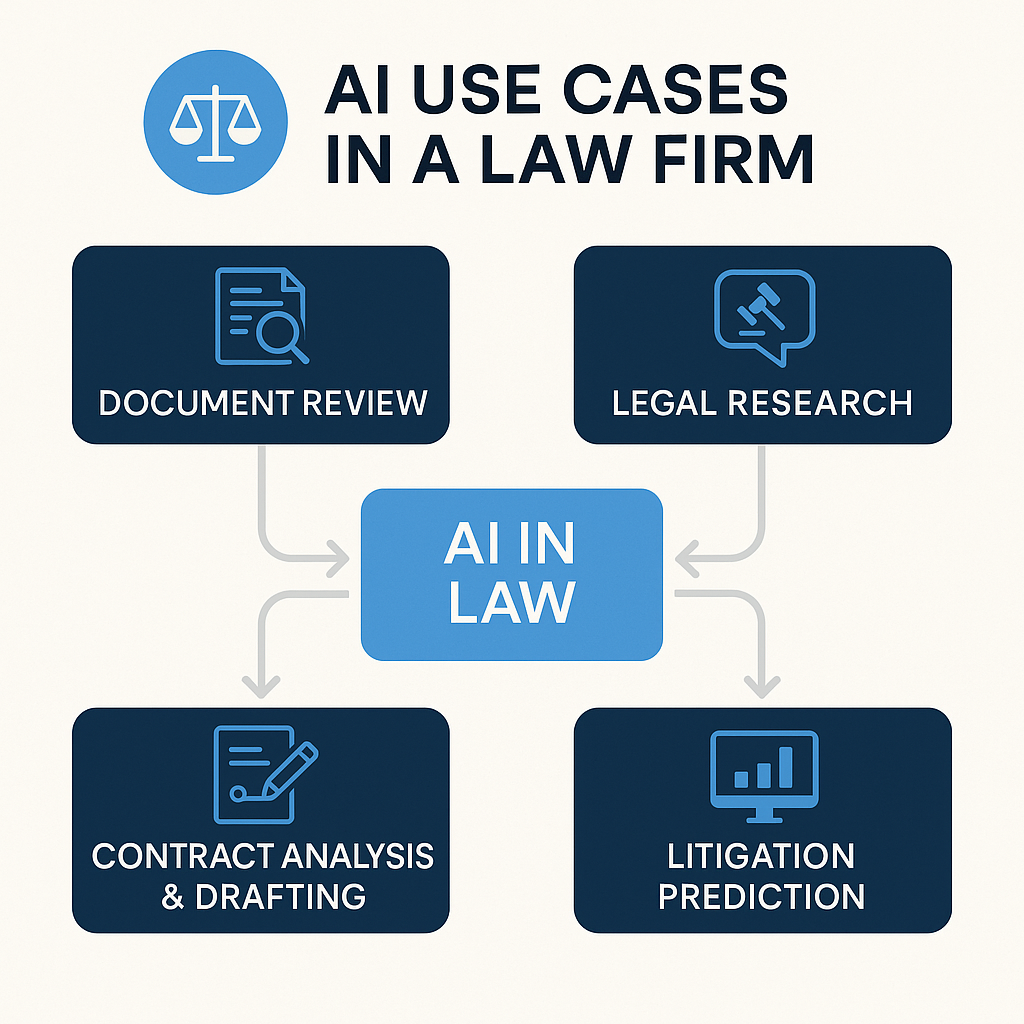Explore how AI is transforming the legal profession — from contract analysis and legal research to litigation prediction. Can machines really practice law?
Exploring the Role of AI in Legal Reasoning, Contracts, and Courtrooms
The legal profession, traditionally resistant to technological disruption, is now facing a profound transformation. Thanks to advances in artificial intelligence, LegalTech — the fusion of law and technology — is automating tasks once thought exclusive to attorneys: legal research, contract review, even predicting case outcomes. But can machines truly “practice law”?
This blog unpacks how AI is used in the legal domain today, its technical mechanisms, regulatory concerns, and what the future holds.
⚖️ What Is LegalTech?
LegalTech refers to the use of software and technology to provide legal services. AI-powered LegalTech applies machine learning (ML), natural language processing (NLP), and large language models (LLMs) to automate legal tasks.
AI Use Cases in Law:
- Document review and eDiscovery
- Contract analysis and generation
- Legal research
- Case law summarization
- Compliance automation
- Litigation outcome prediction
- Virtual legal assistants and chatbots

🧠 What Can AI Do in Legal Workflows?
1. 📄 Contract Review & Generation
AI tools extract key terms, suggest edits, and identify risky clauses.
| Tool | Features |
|---|---|
| Kira Systems | Clause classification, risk detection |
| Juro | AI-assisted contract drafting |
| Ironclad | Workflow automation for contracts |
🚨 NLP models trained on thousands of contracts can flag deviations from standard terms in seconds.
2. 🔍 Legal Research & Summarization
AI helps lawyers navigate massive case law databases and summarize relevant opinions.
| Tool | AI Capabilities |
|---|---|
| Casetext CoCounsel | GPT-based legal research assistant |
| Lexis+ AI | LLM-backed case law summarization |
| Harvey AI | End-to-end research, memo writing, summarization |
🧠 AI legal assistants parse statutes, case law, and regulations using transformer models fine-tuned on legal texts.
3. 🧾 eDiscovery & Compliance
AI reduces manual labor in scanning emails, files, and messages during litigation or audits.
- Uses supervised learning to classify privileged or relevant documents.
- AI redacts sensitive PII or protected data automatically.
- Flags anomalies for regulatory compliance (e.g., GDPR, HIPAA).
4. 🤖 Virtual Legal Assistants
Law firms and startups are deploying AI chatbots to assist clients with common legal queries.
| Platform | Functionality |
|---|---|
| DoNotPay | AI chatbot for contesting tickets, cancellations |
| LISA | Legal Intelligent Support Assistant (contracts) |
| LawDroid | Law firm automation assistant |
🗣️ These assistants use LLMs like GPT-4 or Claude trained with jurisdiction-specific legal datasets.
5. 🔮 Litigation Analytics & Case Prediction
Predictive analytics models analyze historical data to estimate litigation outcomes, judge behavior, and case duration.
| Tool | Features |
|---|---|
| Lex Machina | Judge/lawyer analytics, motion success rates |
| Premonition | Predicts legal outcomes based on court data |
| Blue J Legal | Outcome prediction for tax, labor, and IP law |
🧬 Under the Hood: How Legal AI Works
Technologies Used:
- Natural Language Processing (NLP): Clause parsing, legal language modeling
- Machine Learning (ML): Classification of relevant documents
- LLMs (like GPT-4): Conversational legal guidance and summarization
- Rule-based Systems: Legal logic codified in decision trees
- Knowledge Graphs: Linking legal concepts and precedents
Key NLP Challenges in Law:
- Legalese and complex syntax
- Jurisdiction-specific terminology
- Evolving regulatory frameworks
- Ensuring interpretability and explainability
🧑⚖️ Can AI Legally Practice Law?
The Short Answer: No — not yet.
In most jurisdictions:
- Only licensed human attorneys can give legal advice.
- AI cannot appear in court or represent clients.
- AI-generated contracts and advice may not hold up in legal disputes if not reviewed by a licensed professional.
Regulatory Landscape:
- ABA Model Rules of Professional Conduct emphasize competence and confidentiality, challenging AI adoption.
- EU AI Act and U.S. FTC guidelines classify legal AI as “high-risk” due to potential harms.
- Some courts have banned AI-generated legal documents without attorney review.
🛑 Risks & Ethical Considerations
| Risk | Concern |
|---|---|
| Hallucinations | LLMs may fabricate cases or laws |
| Bias | Discriminatory patterns in historical data |
| Privacy | Handling of sensitive client information |
| Overreliance | Lawyers may blindly trust flawed outputs |
| Accountability | Who is liable for AI errors in legal advice? |
🔮 What’s Next?
- AI copilots for paralegals and lawyers
- Explainable AI for legal reasoning (XAI)
- Custom LLMs trained on firm-specific documents
- Real-time multilingual legal translation
- Blockchain-backed smart contracts integrated with legal AI
The future legal office will likely feature a hybrid model — human experts augmented by AI systems trained on statutes, regulations, and precedent.
Final Thoughts
While AI won’t replace lawyers anytime soon, it is replacing specific legal tasks with unprecedented speed and scale. LegalTech empowered by AI enables faster, cheaper, and more accessible justice — but must be implemented with care, oversight, and legal rigor.
Machines may not practice law, but they’re becoming indispensable legal assistants.